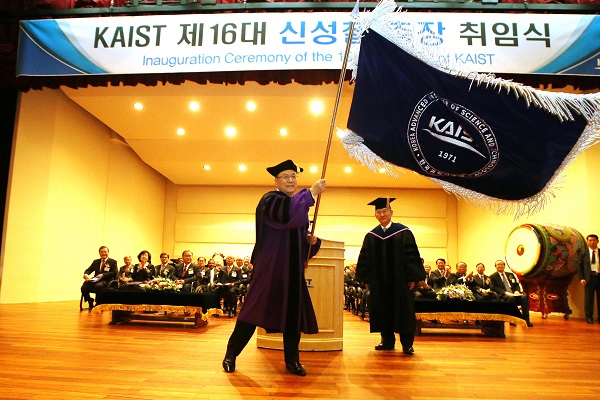
The rooster has awoken a new epoch; while Korea awaits the eventual election of a different leader, KAIST has led the march towards a neoteric age with the election of the 16th President of KAIST Sung-Chul Shin.
On February 27, President Shin greeted the hopeful faces of 760 freshmen and their parents, faculty, and staff at the 2017 KAIST Matriculation Ceremony held at the KAIST Auditorium (E15). Emphasis on global outreach and interdisciplinary sciences hallmarked his speech to the students whose academic career will coincide with his four-year term.
His official Inauguration Ceremony took place soon afterwards on March 15, also at the Auditorium (E15). Preceded by warm felicitations of key figures from governments and academics both domestic and abroad, President Shin presented a research and strategy-oriented inaugural address befitting the audience composed primarily of faculty and guests.
The previous KAIST administrations, particularly those of the former presidents Robert Laughlin and Nam Pyo Suh, had been tenuous, and more than a few voices have laid the blame on their external origins. Thus, it is of little surprise that President Shin had been favored by the Board of Trustees for his lengthy relationship with KAIST, as both a student and faculty. As the first KAIST professor in 12 years and the first graduate ever to serve as the president, he carries the hope of utilizing his deep knowledge of the KAIST community to adapt policies most apt for the university. President Shin has covered an extensive range of careers, from research jobs at Eastman Kodak Research Labs to prominent administrative positions, including the vice chair of the Presidential Advisory Council on Science and Technology (PACST). He has also served as the president of both the Korean Magnetics Society and the Korean Physical Society, employing his specialization in nanoscience.

Amongst such surfeit of accomplishments, the most recent and notable experience of President Shin was his previous appointment as the president of Daegu Gyeongbuk Institute of Science and Technology (DGIST). He resigned from his second consecutive presidency in order to pursue the respective position at KAIST, finally succeeding after four preceding candidacies. His influence at the larval experimental institute forecast the vision he has for the upcoming years at KAIST. The unusual curriculum — such as driving undergraduates to choose their majors in their graduating year — reflected President Shin’s pursuit in encouraging interdisciplinary studies. He announced his intent to adopt the “Non-departmental Education System” at KAIST alongside the traditional major-focused program. His enthusiasm in the integration of different fields of studies was evident from his speech: “The Fourth Industrial Revolution is dawning upon us. In this new paradigm, a majority of new discoveries and inventions will not come from traditional academic fields, but from multidisciplinary convergence.” He reinforced his argument by emphasizing the need for deeper learning in all basic sciences as the strong cornerstone for any field, offering examples of real-world figures whose achievements were an amalgamation of diverse scientific areas as well as humanities such as Steve Jobs and Demis Hassabis.
Beyond intellectual mastery, President Shin reiterated KAIST’s growing interest in nurturing global leaders through the education of communication skills and the English language, as its status as the lingua franca of the modern age — especially in the academics — is a prerequisite to many, if not all, career paths. In fact, his delivery was interleaved with hopes for Korea’s evolution into a global spearhead of innovation through the individual contributions of the bright minds entering the university. He teased possible implementations of the Global Leadership Center, which would prepare the students with “the traits, manners, and mindset of a true global leader”.
His final advice to the freshmen was of a more practical nature — “As you begin a new life at KAIST, you must take responsibility over your own time schedule and manage it wisely.” President Shin urged students to seize control of their time and resources in order to materialize their dreams from imaginations into reality.
Though the specific implementation of his agenda during his term of office remain shrouded, President Shin offered a clear outlook into what type of institution he intends to guide KAIST towards. The next few months anticipate a season of blooming changes. For more information, consult The KAIST Herald’s interview with President Shin personally for an in-depth view into his plans and policies on page 12.

